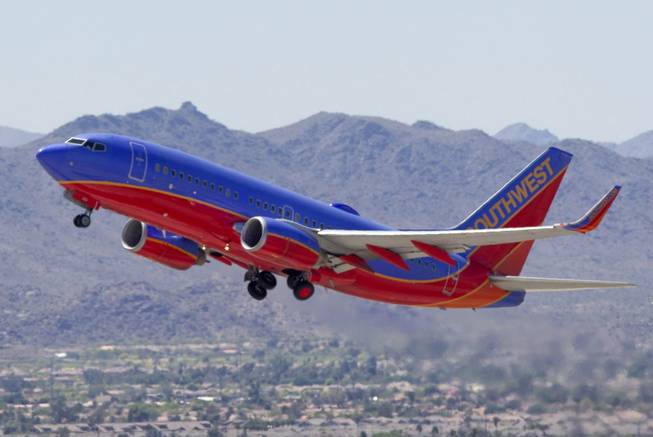
Matt York / AP
A Southwest Airlines jet takes flight in this undated file photo.
Tuesday, April 1, 2014 | 1:04 p.m.
KUALA LUMPUR, Malaysia — An aviation industry group is creating a task force to make recommendations this year for continuously tracking commercial airliners because "we cannot let another aircraft simply vanish" like Malaysia Airlines Flight 370.
As low clouds, rain and choppy seas off western Australia hampered Tuesday's hunt for the missing jet, the head of the operation warned that the 25-day-old search "could drag on for a long time," and Malaysian investigators said they were scrutinizing the last-known conversation between the plane and ground control.
The search has turned up no sign of the Boeing 777, which vanished March 8 with 239 people aboard bound for Beijing from Kuala Lumpur. A multinational team of aircraft and ships are searching the southern Indian Ocean for the plane, which disappeared from radar and veered off-course for reasons that are still unexplained.
The aviation mystery has highlighted the need for improvements in tracking aircraft and security, according to the International Air Transport Association, a trade association for the world's airlines meeting in Kuala Lumpur.
"In a world where our every move seems to be tracked, there is disbelief that an aircraft could simply disappear," said Tony Tyler, the director general of the group whose 240 member airlines carry 84 percent of all passengers and cargo worldwide.
"We cannot let another aircraft simply vanish," he said in announcing the high-level task force to make recommendations on tracking commercial aircraft.
Tyler also urged improvements in screening passengers before boarding.
The presence of two men on the Malaysia Airlines flight with stolen passports had raised speculation of a possible terrorist link, but it is now thought they were asylum seekers bound for Europe. Nonetheless, Tyler said their easy access to the flight "rings alarm bells."
Malaysia's government, responding to repeated media requests, released a transcript of the conversation between Flight 370 and air traffic control, which showed normal exchanges as the pilots requested clearance for takeoff, reported it had reached cruising altitude and left Malaysian airspace.
"Good night Malaysian three-seven-zero," were the final words received at 1:19 a.m. on March 8 by ground controllers at Kuala Lumpur's international airport. That was a change from what had been originally transcribed as "All right, good night."
There was no explanation for the change. The conversation was in English, the universal language of aviation.
Investigators were scrutinizing the conversation to determine if there was any stress or tension in the voice of whoever was communicating with ground control, the government said.
It added that investigations were trying to confirm if the voice in the final conversation was that of the co-pilot, as was earlier believed.
Malaysia has been criticized for its handling of the search, particularly its communications to the media and families of the passengers.
Angus Houston, who heads the joint agency coordinating the multinational search effort in Perth, Australia, said the operation was the most challenging one he has ever seen.
The starting point for any search is the last known position of the vehicle or aircraft, the former Australian defense chief said.
"In this particular case, the last known position was a long, long way from where the aircraft appears to have gone," he said. "It's very complex, it's very demanding."
"What we really need now is to find debris, wreckage from the aircraft," he said. "This could drag on for a long time."
The focus of the search has shifted as experts analyzed limited radar and satellite data from the plane, moving it from the seas off Vietnam to several areas in the Indian Ocean west of Australia. The current search zone is a 254,000-square-kilometer (98,000-square-mile) area roughly a 2½-hour flight from Perth.
The 11 planes involved in the search Tuesday returned to their base in Perth without any significant sightings, the Australian Maritime Safety Authority said.
Because of the weather, a Japanese coast guard plane with high-performance radar and infrared cameras completed just one of its three planned passes over the search area, then turned back. It descended to just 150 meters (500 feet) above the whitecaps at one point, but the crew members still couldn't see anything out the windows.
Some of the aircraft have occasionally dipped even lower for brief periods, raising concerns of collisions with ships in the zone.
On Tuesday, Australia deployed an airborne traffic controller to prevent collisions. An Australian air force E-7A Wedgetail equipped with advanced radar made its first operational flight, AMSA said.
Under normal circumstances, ground-based air traffic controllers use radar and other equipment to track all aircraft in their area of reach and direct planes so they are at different altitudes and distances. But the planes searching for Flight 370 are operating over a patch of ocean that is hundreds of kilometers (miles) from any air traffic controller.
Associated Press writers Rod McGuirk in Canberra, Australia, Kristen Gelineau in Sydney, and Jocelyn Gecker in Bangkok contributed to this report.


Join the Discussion:
Check this out for a full explanation of our conversion to the LiveFyre commenting system and instructions on how to sign up for an account.
Full comments policy